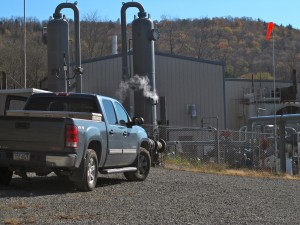Cancer causing air toxins detected at frack sites
-
Susan Phillips

Katie Colaneri/StateImpact Pennsylvania
A compressor station pumps natural gas into the Tennessee Pipeline in Dimock, Pa.
A peer reviewed study published Thursday in the journal Environmental Health reveals dangerous levels of air toxins near fracking operations. The carcinogen formaldehyde was the most common chemical found to exceed federal safety levels, according to Denny Larson, one of the report’s authors. Larson works with the nonprofit Global Community Monitor.
“The number of [chemicals] that we found near these sites are alarming,” said Larson in a call with reporters. “They are, as the title of our report clearly says, a warning sign.”
The deadly chemical hydrogen sulfide was also found in high levels in Wyoming samples. Hydrogen sulfide is known to kill oil field workers. A recent report by EnergyWire documents the dangers to shale oil production workers from air toxins.
Volunteers in six states, including Pennsylvania, took air samples for the study. Pennsylvania’s samples show high levels of formaldehyde near compressor stations. The research was led by David Carpenter, a physician and director of the Institute for Health and the Environment at New York State University at Albany. Carpenter says he’s most concerned about the high levels of benzene and formaldehyde measured by the volunteers.
“One thing about cancer is that it doesn’t happen tomorrow after exposure,” said Carpenter. “Cancer ususally takes at least five, but more often 10, 20 or even 30 years to develop. So our concern is that these carcinogens that were monitored near homes, near schools, near farms with animals, the people that are exposed are going to be at risk of developing cancer. But it will only appear in the future.”
He says the formaldehyde is formed in two ways. One by combustion at compressor stations, but also as a byproduct of methane leaks, when exposed to the sun.
Rebecca Roter, with Breathe Easy Susquehanna County, participated in the study as a volunteer. Roter says she lives less than a mile from a compressor station and says her health has deteriorated as a result. Roter emphasized the importance of data collection.
“Getting the data is key because it gives us the teeth to try and change the dialog,” said Roter.
“We’re hoping that getting data like what was generated in this project will get the attention of our community officials and legislators and drive the dialog so we can limit our chemical exposure.”
Evidence for air toxins emitted by natural gas drilling activity is mixed, which could be a result of the difficulty surrounding the collection of data. Air quality is impacted by many variables including the weather, the stage of gas development, and the type of industrial activity. Researchers say it’s also difficult to quantify the public health impacts.
A 2010 air monitoring study by the Department of the Environment Protection did not find dangerous levels of air toxins at frack sites. And an industry group is questioning the methodology used in this most recent report. Katie Brown from Energy In Depth says the “bucket method” used by the volunteers described in a 2001 EPA memo has flaws. Brown writes that the methods raise “huge red flags.” And she questions the politics of the volunteers, many of whom belong to groups that oppose gas drilling. Brown says better air monitoring methods exist, but could not describe those in detail.
The study received funding from the V. Kann Rasmussen Foundation, the Center for Health, Science, and Public Policy, and the Institute for Health and the Environment.
















